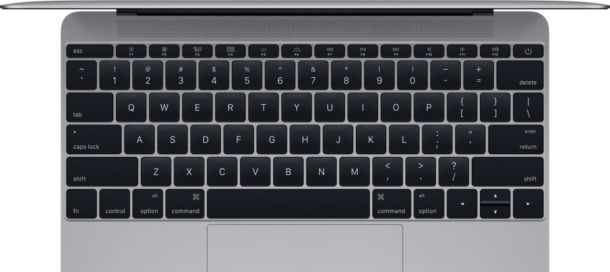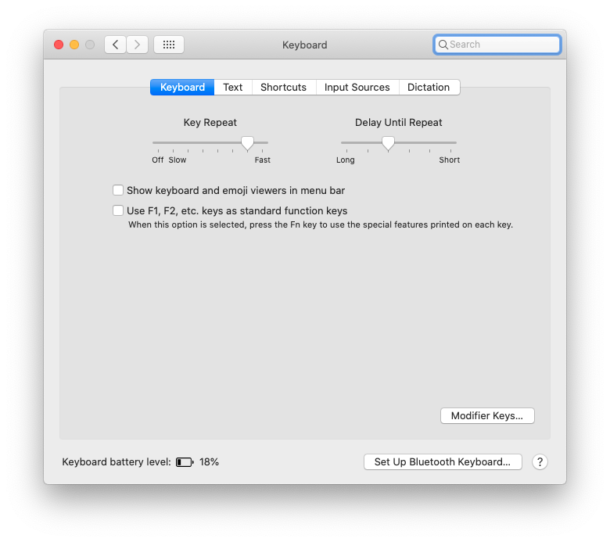What Do the F1, F2, F3, Through F12 Keys Do on Mac Keyboards?

If you’re sat in front of your Mac now, take a look down at your keyboard. Sure, it has all of the characters you’d expect from a keyboard, but there are some keys along the top of the keyboard that might not be familiar to you. These are called function keys and all have Fx written on them, where x x is replaced with a number, like F1, F2, F3, F4, F5, F6, F7, F8, F9, F10, F11, F12. So what do the the F keys on a Mac do?
Glancing at the F keys on a Mac keyboard, you’ll see an icon if you look above the function key number, and that icon shows what else the key can do. And with 12 keys to choose from, they can do quite a bit. Additionally, standard function keys can be used within different apps in different ways, so be sure to check the keyboard shortcut options for your favorite apps to see if there are any that you should be making use of.
Below is a list of the functions available for all of the Mac function keys. They should all be present and correct if you’re using an Apple keyboard on almost any modern Mac, except for any Mac with a Touch Bar anyway which uses a little screen instead of the F keys. Of course some much older Macs may have different functions assigned to the F keys too, so we’re assuming you’re on modern hardware.
What the F Keys Do on Mac Keyboards
These are the primary defaults of what function keys do on an Apple keyboard when connected to a Mac:
- F1 – Decrease display brightness
- F2 – Increase display brightness
- F3 – Open Mission Control
- F4 – Open Launchpad
- F5 – Decrease keyboard brightness (On compatible notebooks only)
- F6 – Increase keyboard brightness (On compatible notebooks only)
- F7 – Skip back (Audio)
- F8 – Pause / Play (Audio)
- F9 – Skip forward (Audio)
- F10 – Mute
- F11 – Volume down
- F12 – Volume Up
Pressing a function key will invoke its secondary function by default.
To use the Fx keys as standard function keys, press and hold the Fn button and then press the required function key.
If you’re using a non-Apple keyboard that doesn’t have an Fn key, try pressing and holding the Control key instead.
Changing Function Key Behavior on Mac
You can change the default behavior of the function keys on Mac too, however. This basically inverts their function away from defaulting to things like brightness and audio controls to standard F keys.
- Open System Preferences from the Apple menu
- Click “Keyboard” from system preferences
- Select “Use F1, F2, etc. keys as standard function keys” to make the change.

If you make this change, you’ll need to press down the “FN” key on the keyboard and then press the F1, F2, F3, etc keys to perform the action that is on the keys icon (for example, changing brightness, or muting system volume). Some users on older Macs in particular prefer this, as we covered previously some time ago.
Similarly, if you’re using a MacBook Pro with a Touch Bar, press and hold the Fn key to see the F1 through F12 keys and then tap the screen to use them.
Where is the FN key on a Mac keyboard?
The FN key is in the lower left corner on modern Mac keyboards with a US layout. It is labeled with ‘fn’ and a globe icon on the newest Macs, or simply ‘fn’ on slightly older machines.

The FN key is necessary to access the alternate function row key options, depending on how your Mac keyboard is configured. The fn key is also sometimes used in keyboard shortcuts.
–
If the Mac has a Touch Bar but you’d like to always see the function keys, you can actually disable the Touch Bar on MacBook Pro so that the Touch Bar remains the same all of the time, you can set it to either show an F key row or the actions row, whatever you prefer.
If you’re new to the Mac you may not know about some of the other cool tricks you can do with the Fn key, like move “Home” and “End.”
If your keyboard isn’t working properly you can also enable a software-based virtual keyboard, too, but often cleaning the Mac keyboard can improve key press issues.
This obviously is aimed at Mac keyboards either from Apple or third parties, but if you’re using a third party PC keyboard and you have a different set of F keys (or even none at all), you can consult your keyboard’s manufacturer for more information about the function row.
There are a ton of other keyboard shortcuts, like navigating text amongst many others that are well worth learning if you spend a lot of time typing on a Mac as well. They’ll completely change your game once you master the ones that you use most.
Do you use the function keys often? Have you changed the behavior of any of the F keys for any other purpose? Let us know your experiences and thoughts in the comments.


On my old Mac, standard keys Fn9 and F11 were particularly useful for lining up a sample of photos you’d worked on and comparing the previews. F11 also got rid of all open apps/windows on desktop so you could see behind. Press it again and they appeared. I am mourning these having disappeared and nobody has yet been able to say how to get them back. I have tried setting to ‘use as standard keys’ but nothing happens. Old computer was desktop circa 2011 El Capitan. Brand new M2 mac air running Ventura but keyboards look pretty similar. Thanks
I found the tips explanatory and very helpful for me. Thank you
is there a Screen print key on the MacBook Air
Thank you for listing the uses for the F keys.F3 at Mission Control and F4 at Launch pad sound like I should be able to send space ships off to the moon. I assume there is something much more practical for these?
I don’t have light on my keyboard so assume that F 5 and F6 would thus be useful for some other function?
I am possibly going to find pause and play audio with some information that is from the Great Courses when I figure out how to access them . Hope for me yet, Dorothy at 79
Finally, a good communicator, but where is the Fn button?
In the pictured keyboard, and most current Macs, at the lower left corner.
Years ago – on a BBC-computer – I could perform a Change Case command on the character next to the cursor just by typing Ctrl D
After performing the change of case the cursor moved up one position so that you could repeat the action on and on.
Very handy indeed.
How to implement such a desire on an iMac?
Actually, neither of my Macs (Air and Macbook) has all of the characters I’d expect from a keyboard. There’s no forward delete, only a backspace key. Forward delete must be emulated by Fn + backspace.
Press the ‘fn’ key with the ‘delete’ key forward delete.
Thanks!
I found out that if you press the esc key you exit fullscreen mode. Not on all apps tho… the cmd+ctrl+F shortcut works always to enter and exit fullscreen mode.
Anyways I want to think you were being a bit sarcastic because of how basic and obvious this article was.
The first half of your comment is constructive, but the second half is not. I am actually getting tired of reading backhanded compliments like this for a resource you get for free; if you have thoughts like this, do us a favor and keep it to yourself.
Awesome,if you wouldn’t have said it, I was completely ignorant..
Really useful – thanks yet again…
Don’t suppose you have a list of the other hidden characters – such as the # – which I use a lot for writing music – and I always forget the combination!
! is shift 1
@ is shift 2
# is shift-3
etc
use the Shift key plus the numerical key on the keyboard to type those characters. Lots of hidden special characters too in MacOS available through the option key.
is option + shift + K
;)
For years and years I’ve ignored that row of F keys because I never knew what they were for. I’m going to save the list so I can refer to it. I’m so glad you have taken the time to explain them!
Both interesting & helpful!